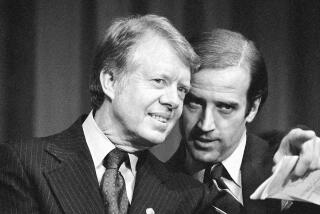100-day Obama crystal ball is cloudy
It has become more than a cliche: Every new president’s first 100 days are a crystal ball foretelling the course of his administration.
But today, as we mark Day 101 of the Obama era, the danger in our sound-bite and Twitter-laden information society is that we’ll start judging the president in artificial slices of roughly three months each, the way corporate executives live and die by their quarterly reports.
I can see us calculating the Dow Jones industrial average’s performance for each 100-day interval. (The Dow fell 1.2% in President Obama’s first Hundred Days, but the Nasdaq soared 12%. Hey, I’m as much a creature of the zeitgeist as the next guy.)
We’ll tally bills vetoed, flu shots delivered and promises made, kept or broken.
At work Wednesday I was greeted with a news release proposing what Obama should do to fix the commercial real estate market in “the second hundred days,” and was gripped by a vision of the abyss.
But events in the real world don’t unfold in discrete packets any more than do the fates of major corporations. Nor do the frenetic first three months of any presidency tell us much about the months to follow.
The best illustration of that is the Hundred Days associated with Franklin D. Roosevelt’s first term, the first Hundred Days to be given the name.
History doesn’t tell us who first dubbed this period the Hundred Days. As it happens, the reference didn’t mark the days since FDR’s inauguration, but the length of the special session of Congress he convened March 9, 1933, to enact emergency legislation -- a session that ended after 100 days on June 16, the 105th day of FDR’s presidency.
Roosevelt himself first used the phrase in its totemic sense about five weeks after the event, during his third fireside chat, on July 24, when he evoked for his audience the “hundred days . . . devoted to the starting of the wheels of the New Deal.”
As was his habit, FDR was overselling the New Deal by presenting it as a full-blown and fully consistent economic program. In truth, as Raymond Moley of FDR’s “Brain Trust” wrote later, the Hundred Days were as haphazard an agglomeration of found objects as “the stuffed snakes, baseball pictures, school flags, old tennis shoes, carpenter’s tools, geometry books and chemistry sets in a boy’s bedroom.”
Little of what happened during that period gave a clue to Roosevelt’s political philosophy. The 15 major bills enacted then included many that delivered on FDR’s pledge of a “New Deal for the American people” in his nomination acceptance speech at the 1932 Democratic convention -- among them programs for emergency relief, the refinancing of home and farm mortgages and a public power system for the Tennessee Valley.
But any pundit judging FDR from the totality of his Hundred Days might conclude him to be a leader more orthodox in his economic thinking than Herbert Hoover, for he also was fixated on balancing the budget. The second bill he sent to Congress after the inauguration was a measure that cut the salaries of federal workers and slashed veterans’ pensions to pare $500 million from the federal budget.
Through the National Industrial Recovery Act, moreover, the Hundred Days set the foundation for a system of federally sponsored industrial cartels and monopolies, with an ambiguous nod to labor’s right to collective bargaining, that arguably slowed economic recovery over the next couple of years. Roosevelt was so skeptical about the effectiveness of public works as an economic stimulus that when Congress granted him a $3.3-billion construction program, he placed it in the hands of the Cabinet member least likely to put the money to work rapidly, the curmudgeonly and exceedingly mistrustful Harold Ickes. And FDR’s approach to international economic relations was dismissive almost to the point of isolationism.
As for the most crucial banking reform of the period, federal deposit insurance, he initially threatened a veto, figuring that it would lead to bad banks dragging good banks into losses. Luckily for all of us, the measure’s supporters brought him around, and later, when it proved to be one of the most successful initiatives of the New Deal, he wasn’t shy about taking credit.
As historian David M. Kennedy has observed, only some of the ideas in the Hundred Days were Roosevelt’s. Some, including an emergency banking measure, were Hoover’s. Some arose from special interest groups or congressional blocs. All that can be said of them as a whole, he wrote, was that they “reflected Roosevelt’s penchant for action . . . and his receptivity to all kinds of innovation.”
Obama has embraced the romantic legend of FDR’s Hundred Days but not its messy reality. His first 100 days have encompassed a stimulus bill grander than anything Roosevelt would have dared at the same stage of his administration, and a reversal of his predecessor’s policies more dramatic than anything Roosevelt attempted.
Obama might be better advised to heed a lesson from later on in FDR’s administration. When signs emerged in late 1935 and 1936 that an economic upturn was underway, Roosevelt cut back the recovery program. His reward was a painful recession in 1937.
That suggests that Obama’s stimulus program might soon reach a perilous phase. The spotty but proliferating signs of a bottoming-out economy will inspire calls to cut spending or even abandon part of the $787-billion stimulus package. History warns against it.
But beyond that, any crystal ball based on the record of past administrations is bound to be cloudy. The first 100 days are less a guide to the actions and goals of a presidency than to its character.
FDR’s Hundred Days showed him to be a nimble political maneuverer with a taste for experimentation; Obama’s have shown him to be a thoughtful leader with a consistently activist philosophy, intent on exploiting a crisis to achieve progressive political ends. But how well he will accomplish his goals is no more visible on April 30, 2009, than it was to Roosevelt’s followers after June 16, 1933.
--
Michael Hiltzik’s column appears Mondays and Thursdays. Reach him at michael.hiltzik@latimes.com, read his previous columns at www.latimes.com/hiltzik, and follow @latimeshiltzik on Twitter.
More to Read
Inside the business of entertainment
The Wide Shot brings you news, analysis and insights on everything from streaming wars to production — and what it all means for the future.
You may occasionally receive promotional content from the Los Angeles Times.











